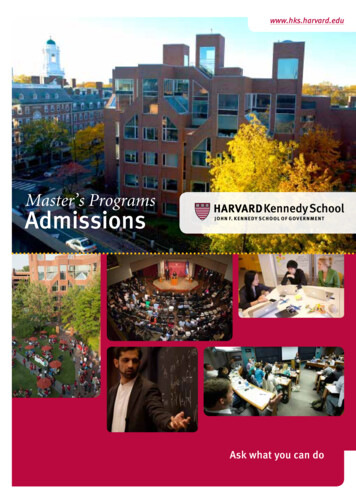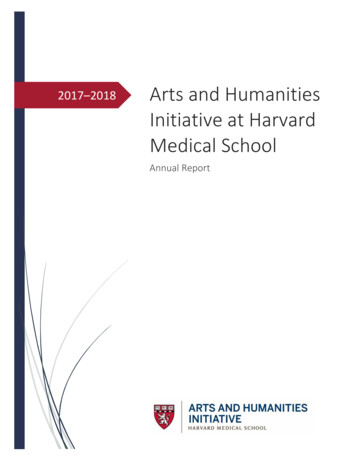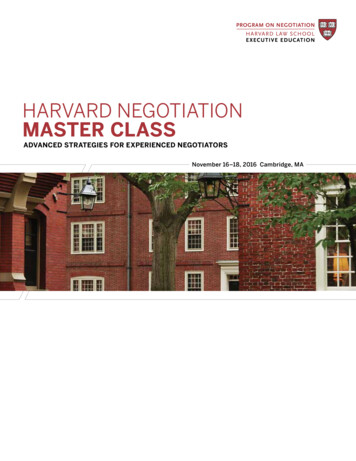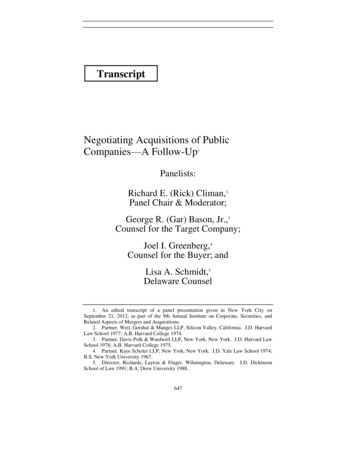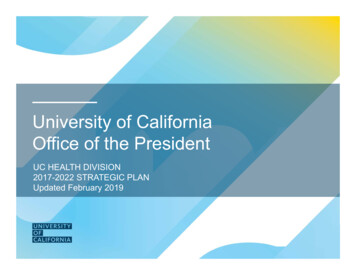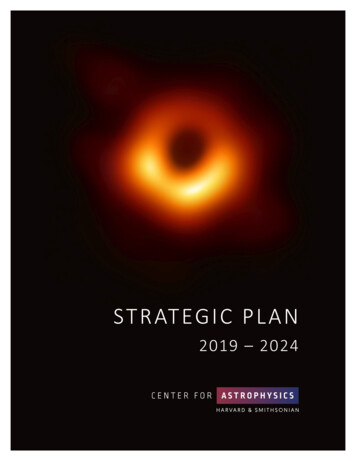
Transcription
ST R AT EG I C P L A N2019 – 2024
From the DirectorCharles Alcock joined the Center for Astrophysics Harvard &Smithsonian (the “CfA”) as its third director in 2004. Beforecoming to the CfA, Dr. Alcock had been a professor of astronomy at the University of Pennsylvania. With a single director,the CfA has maintained the unified vision and strategic priorities that brought it to world leadership in the decades followingits first phase of dramatic growth in the 1960s to early 1970s.The Center for Astrophysics Harvard & Smithsonian is the union of two distinct entities, theHarvard College Observatory (HCO) and the Smithsonian Astrophysical Observatory (SAO).Founded in 1839, HCO installed the 15-inch telescope known as “The Great Refractor” in1847. SAO was founded in 1890 and grew to prominence first with Secretary Langley’s studyof the Sun. In 1955, SAO relocated to Cambridge, MA, to explore collaborations with HCO.The Harvard-Smithsonian Center for Astrophysics was established in 1972. There have beenmany exciting developments in the time since, and today the CfA conducts observationalresearch across the electromagnetic spectrum, investigating the Universe at scales rangingfrom our own star, the Sun, to the cosmic background radiation. Theoretical and computational investigations provide explanations that force us to ask us new compelling — anddifficult — questions.The CfA substantially influenced modern astronomy and astrophysics, bringing astronomyand the laboratory disciplines ever closer together. The relationship between physics andastronomy is now mature, although some of the most important questions remain unanswered, including: What happens at the event horizon of a black hole?Now in the 21st Century, CfA scientists are making significant connections between astronomy, physics, chemistry and biology, extending now to include the search for evidence oflife on an exoplanet!Our strategic goals are driven by the largest scientific questions facing humanity: What is thestructure of the Universe and what is it made of? Where did we come from? Are we alone? i
Strategic Plan 2019-2024September 23, 2019SectionsI.CfA 2019: Our Distinctive Characteristics.1II. Build Major New Facilities for Optical/Infrared and X-ray Observations.2III. Advance Broad Research Programs.5IV. Strengthen the Interdisciplinary Framework for Research.9V.Strengthen the Harvard & Smithsonian Collaboration.12VI. Conclusion.14ii
AcknowledgmentsIn anticipation of developing a strategic plan, the Director’s Office engaged in a number ofactivities with the community over the past few years, including small group meetings and CfAwide meetings. Our request for white papers produced 22 thoughtful suggestions. We have alsopresented early drafts of this plan to the SAO Advisory Board and the CfA Visiting Committees. Wealso acknowledge the writing and editing contribution of Amanda Preston.iii
I. CFA 2019: OUR DISTINCTIVE CHARACTERISTICSMissionThe Center for Astrophysics (CfA) is a collaboration between Harvard University and the Smithsonian Institution, through our respective observatories, the Harvard College Observatory (HCO)and the Smithsonian Astrophysical Observatory (SAO). Our mission is to advance knowledge andunderstanding of the Universe through research and education in astronomy and astrophysics.ProgramsAs one of the largest groups of astronomers and astrophysicists in the world, with some 250 Ph.D.researchers on a staff of 700 total employees, fellows, and students, we conduct curiosity-drivenresearch into fundamental questions about the Universe and our place in it.We design, develop, and carry out observational, theoretical, and experimental programs toaddress these questions, building and operating facilities as required. We have the breadthof expertise across the electromagnetic spectrum to probe the structure and evolution of theUniverse from small to large scales. We use our combined resources to train many of the mosttalented students and postdoctoral fellows in the world.StructureThe CfA is a collaboration betweentwo very different institutions whosecombined purpose is to encourage,nurture and reward individual aswell as group research. Its directors,present and past, have stewardedthis complicated and highly successful institution with “bifocal” attentionto achieving clear goals in the nearterm and maintaining full readinessfor a future that is envisioned but notyet established within the uniquelyself-reflective field of astrophysics.FundingCfA's Influence:Election to the National Academy ofSciences is one of the highest honorsaccorded a U.S. scientist or engineer.The Center for Astrophysics has figuredin the backgrounds of many of today’sAcademy members. Of the 96 currentmembers in the Astronomy section,41% were either educated at, taughtat, or served as researchers at theCfA. Today, eleven CfA scientists areAcademy members, ten in Astronomyand Astrophysics, and one in Physics.The CfA is a fiscally diverse institution, allowing significant flexibility in funding its activities. Aportion of our scientists hold positions funded through the Smithsonian Institution’s federalbudget; others receive funding through contracts and grants to the Smithsonian. The Harvardfaculty, who are distinguished researchers in addition to their teaching activities, are on University salaries. We seed new programs and support large proposal efforts through internal support,much of which derives from the indirect costs on our contracts and grants. We rely on externalsupport from public sources, primarily NASA and the NSF, and from private sources, both individuals and foundations, some in the form of endowments. We partner strategically with manynational and international institutions to carry out our long-term projects.1
About This PlanThis is an excellent moment to consider the future directions in our field and the future of our intellectual leadership. This document describes the joint scientific vision of the Smithsonian Astrophysical Observatory and the Harvard College Observatory. It expresses our current and plannedcommitments (scientific and operational) and our planned focus on key research questions andproblems for the next five years. It also speaks to the need for agility in our rapidly evolving field.This plan will guide the allocation of resources, not only financial decisions, but also in scientistpositions, administrative and technical support, and in our physical workspace. Our science goalsadhere closely to the Smithsonian Institution’s 2017 Strategic Plan theme, “Unlocking the Mysteries of the Universe,” and to the spirit of Harvard’s new leadership under President LawrenceBacow. Our intention with this five-year plan is to present our internal CfA strategic goals on atimescale consistent with discussions to take place at the national level through the Astronomyand Astrophysics Decadal Survey .1This document is intended for a broad audience, ranging from the leadership of our parent institutions to the visitors to our website, to our funding agencies, to our current and prospectivedonors, as well as to our collaborators (individual and institutional), journalists, and prospectivestudents, fellows, researchers, technical and administrative employees.II. BUILD MAJOR NEW FACILITIES FOR OPTICAL/INFRAREDAND X-RAY OBSERVATIONSThe CfA will play major roles in two new observing facilities essential to our core research and topreserving our observational capabilities in the optical/infrared and in the X-ray regimes. This priority is a continuation of two major strategic goals originating in our 2007 Strategic Science Plan, eachof which we expect to be considered in the Decadal Survey’s process.1. The Giant Magellan Telescope (GMT)This spectacular telescope will have a collecting area equivalent to a primary mirror that is 25.2meters in diameter. Located in northern Chile, it will operate at one of the best sites in the worldfor astronomy. The international partnership building the GMT comprises twelve leading institutions.2 Our science goals for the GMT are both complementary to and synergistic with NASA’sJames Webb Space Telescope (JWST), as well as with other current and planned space- and groundbased facilities.The Astronomy and Astrophysics Decadal Survey is an influential study run jointly between the Board ofPhysics and Astronomy and the Space Studies Board of the National Academies. The goal of a decadal survey isto consider the past and current research of the field and provide consensus recommendations for the directionof the field over the next decade. These recommendations are made by a survey committee which is directedby the statement of task and informed by community input. (From: ects/SSB 185159#About the Survey)2Arizona State University, Astronomy Australia Ltd., Australian National University, Carnegie Institution forScience, FAPESP – The São Paulo Research Foundation, Harvard University, Korea Astronomy and Space Science Institute, Smithsonian Institution, Texas A&M University, The University of Texas at Austin, University ofArizona, University of Chicago.12
The Giant Magellan Telescope, here depicted in an artist’s conception, is a seven-mirror segmentedsurface whose precision instruments will be mounted in the 22-story enclosure.The CfA leads the team responsible for the extraordinary spectrograph G-CLEF (GMT- ConsortiumLarge Earth Finder). G-CLEF, when mounted on the GMT, will significantly advance the searchfor and characterization of planets around other stars. It is designed to detect the presence ofdiatomic oxygen in the atmospheres of Earth-like planets orbiting nearby stars.Terrestrial O2 is produced by living organisms; these observations will usher in the study of lifeelsewhere in the Universe. The search for life on other planets is one of the key programs of theHarvard University Origins of Life Initiative, which brings senior members from HCO and SAO intocollaboration with other Harvard scientists working on origins questions.The GMT will also address a range of cosmological questions, including “How do galaxies formand evolve?” The GMACS (GMT Multi-object Astronomical and Cosmological Spectrograph) andGMTIFS (GMT Integral Field Spectrograph) instruments will allow us to spectroscopically characterize galaxies at high redshift, as they form at the end of the “cosmic dark ages.” At this unexplored phase of cosmic evolution, when stars within galaxies are forming most vigorously, we maysee infant galaxies formed at the start of reionization evolving into mature galaxies like the MilkyWay, which we inhabit today.3
The recent observation of gravity waves from merging black holes and neutron stars, followedby the spectacular detection of electromagnetic radiation from a merger event, launched gravitational wave astronomy. We expect there will be many related discoveries made with the GMTover its anticipated 50-year life.The CfA also participates in the GMT through active membership on the GMT Observatory Board andthe Science Advisory Committee, as well as leadership in technical design reviews. CfA scientists havealso played a leading role in designing the mirror alignment system.Our goals are to complete the design and construction of the GMT-consortiumLarge Earth Finder (G-CLEF), support the CfA community as it developsscientific plans for using the Giant Magellan Telescope (GMT), and ensurethat our scientists have access to the telescope to carry out their visionaryprograms. As Founding Partners, we will work with the GMT Organization(GMTO) to proceed toward completion and operation of the GMT.2. The Lynx X-ray ObservatoryThe National Academy of Sciences’ DecadalSurvey for the 2020s will evaluate and comparefour large, strategic space mission concepts andmay select one for recommendation to NASA.Given the scope of our interests, CfA scientistswill benefit from any of the missions underconsideration; however, Lynx uniquely plays tothe strengths of the CfA.The CfA has played a leading role in X-ray astronomy since the pioneering work of Nobel Prize Lynx is being developed to address three sciencerecipient Riccardo Giacconi, his colleagues, “pillars:” the dawn of black holes, the drivers ofand his protégés, and now hosts the Chandra galaxy evolution, and the energetic side of stellarX-ray Center. We are uniquely qualified to work evolution and stellar ecosystems. CfA scientistswork in all of these areas. on the technical development and scientificprograms of Lynx (formerly known as the X-ray Surveyor). Lynx is a critically important successorto the Chandra X-ray Observatory. We note that the proposal to NASA that led to Chandra wassubmitted in 1976; Chandra was launched in 1999; we anticipate that the mission will continuethrough 2027!Lynx will have a throughput as much as fifty times greater than Chandra’s, and will provide subarcsecond imaging over a twenty times larger solid angle. This combination will allow Lynx to reach a factorof 100 greater sensitivity to faint point sources and survey the sky 1000 times faster than Chandra.Lynx will be able to detect seed-mass, 104 M , black holes out to redshift of 10 to establish the originof central black holes and their role in galaxy formation. It will also measure hot gas and energeticfeedback to study drivers of galaxy formation. Lynx and the GMT will work hand-in-hand to studystellar populations of different types and ages well outside of our immediate cosmic neighborhood.It is expected that, if selected, Lynx will be launched in the 2030s. 4
The CfA has invested discretionary resources for more than a decade in critical technology development for Lynx, in particular in light-weight, adjustable X-ray optics, through SAO’s InternalResearch and Development funding. This optics development program also receives significantNASA funding. The CfA’s leadership in high resolution X-ray spectroscopy, through support ofX-ray laboratory astrophysics and ongoing mission development (e.g. Arcus, XRISM, and Athena),bodes well for leadership in the Lynx mission. CfA scientist Alexey Vikhlinin is Co-Chair of the NASAScience and Technology Definition Team for Lynx.Lynx is a mission concept study commissioned by NASA in preparation for theDecadal Survey. The science to be conducted with Lynx builds heavily on highenergy astrophysics carried out at the CfA.III. ADVANCE BROAD RESEARCH PROGRAMSBalance the Strategic and the ResponsiveDr. Jennifer Yee is an early-career federal scientist studying planets with gravitational microlensing, observed as the bending of light caused by the gravitational effect of a planet (and its host star) in between a background star andthe observer. The independence of CfA scientists frequently leads to importantconnections of their research activities to major missions and projects. Microlensing will be a key program of NASA’s Wide- Field Infrared Survey Telescope(WFIRST) mission, expected to launch and search for planets in the mid-2020s.We must be mindful that the inventiveness of individuals is critical to astronomical discovery.The CfA does now and must continue to foster creativity among its scientists. Harvard and Smith5
sonian resources are essential for this work, and are used to leverage considerable extramuralsupport from NASA and the NSF, as well as other sources of support, including private foundationsand individual donations.It is in the nature of our community to encourage these innovations and to maintain a stable homefor this diverse range of programs, whether they are research programs, new instrument studiesand development, NASA mission participation, specific service to the broad astronomy and astrophysics community, exchange programs with other institutions, or the many other ways in whichour scientists engage in their work and find the support that proves the value of their ideas to thecommunity beyond the CfA.The broad range of research in astronomy and astrophysics at the CfA makes it a unique environment for cooperation and cross-fertilization. Our size and technical diversity enable discoverywithin and across disciplines. Exposure to and participation in this diversity make the CfA a particularly beneficial education experience for our students and junior scientists.We intend to continue providing internal resources for programs and facilities,on small to large scales, that have grown from our scientists’ creative responsesto developments in our field. To enhance this commitment, we will review ourtechnical, program management, and administrative capabilities. SAO internalfunds are a strategic asset to be employed for such opportunities.Respond to New Opportunities as They AriseThrough the matrix of international, national, and non-government partners already working withus, we anticipate new opportunities in the next decade. Many of these will be substantial andrequire new resources with national, international, and private partners. We discuss several suchprograms in various stages of development to illustrate how opportunities arise and evolve:Theory and ComputationTheory and computation give deep insight into the structure and evolution of the Universe weobserve. Theory frequently guides us into new directions which require innovative technologiesand lead to powerful and sensitive observational capabilities. Recent Laser Interferometer Gravitational-Wave Observatory (LIGO) discoveries are textbook examples of the special role of theoryin astrophysics. The CfA has now and will always need a powerful, intellectually compelling theoretical and computational research program. The present center of this at the CfA is the Institutefor Theory and Computation (ITC).In all of the work outlined in this plan, the importance of theoreticalwork will inform our choices and focus our efforts on the most compellingquestions that will arise.6
Radio and Submillimeter AstronomyCfA scientist Dr. Sean Andrews leads one of theSMA research programs focused on protoplanetary disks and their significance in seedingplanets around stars. He also leads a researchprogram with the Atacama Large Millimeter /submillimeter Array (ALMA) whose very high resolution images, e.g. IM Lup (left), show previouslyunknown structures in protoplanetary disks.The Submillimeter Array (SMA), commissioned in 2003 and located near the summit of Mauna Kea,Hawaii, is the world’s first interferometric telescope at submillimeter wavelengths, contributing toresearch from star formation to the black hole at the center of the Milky Way. The SMA is a partnership between the Academia Sinica Institute of Astronomy and Astrophysics (ASIAA) and SAO.CfA scientists will continue to compete for observing time on the largeinternational radio telescope known as the Atacama Large Millimeter/Submillimeter Array (ALMA), and continue to exploit the Submillimeter Array(SMA), innovating with forefront science and the rapid adoption of newtechnologies.Black Hole Astrophysics: Observations and TheoryOn April 10, 2019, the National Science Foundation released the first image of a black hole environment (the center of M87), observed by the Event Horizon Telescope (EHT) and shown on thecover of this Plan. The EHT, led by CfA scientist Dr. Shep Doeleman, connects radio telescopesacross the globe (including the Submillimeter Array, as well as telescopes in Chile, Mexico, Greenland, and at the South Pole) to enable observations of the event horizons of two supermassiveblack holes, the one at the center of the Milky Way and the one at the center of M87. NSF awardedan ALMA 12-meter radio prototype antenna to SAO, providing an opportunity for a critical newnorthern node for the EHT and allowing for unprecedented observations of the northern sky. CfAscientists also lead simultaneous multiwavelength observations of the flaring activity around theMilky Way’s black hole using the IRAC infrared camera onboard the Spitzer Space Telescope, theChandra X-ray Observatory, and the SMA.Now known as the Greenland Telescope, the ALMA antenna hasbeen relocated to Thule, Greenland. Scientists at the CfA leadthis international effort. The Greenland Telescope’s first international observing campaign was conducted in April 2017, withtechnology development and observing campaigns expected tocontinue for as long as a decade.7
Harvard University has launched a new interdisciplinary center called the Black Hole Initiative(BHI), including investigators from the fields of astronomy, physics, mathematics, and philosophy.It is the first center worldwide to focus on the study of black holes. Three CfA scientists are investigators of the Initiative, with the EHT playing a prominent role, complemented by theoretical workthat informs prospective observational programs.Harvard Astronomy Professor Ramesh Narayan(right) and SAO scientist Dr. Michael Johnson (left)use computer simulations to compare with imagesfrom the Event Horizon Telescope of the black holeat the center of our galaxy.The CfA will continue to support the Event Horizon Telescope (EHT).Optical and Infrared Astronomy (not including the GMT)Our observational program in optical and infrared astronomy is presently centered in southernArizona at the MMT Telescope and in Chile with the twin Magellan Telescopes, and in spacewith the Infrared Array Camera (IRAC) onboard Spitzer, a NASA great observatory. The San PedroMartir Telescope (SPMT), to be built by our colleagues in Mexico and located in Baja California,will expand the observing opportunities for our scientists. The SPMT will have an optical prescription identical to that of our existing 6.5-m telescopes, Magellan and the MMT, facilitating theexchange of instruments between them. The skies are exceptionally clear and dark at San PedroMartir, which will allow more sensitive observations than we can make from the Arizona site. Apreliminary design review of the telescope enclosure was held on 11-13 October 2016. A successful preliminary design review of the telescope and optics was held 6-8 November 2017, followedby the beginning of its critical design phase.NASA’s SPHEREx mission, scheduled for launch in 2023, will survey the entire sky with infraredand optical spectroscopic tools, and SAO leads its study of water, ices, and organic molecules ingalactic sources.We are currently working on a Memorandum of Understanding betweenSAO and the San Pedro Martir Telescope (SPMT).Solar PhysicsAs our nearest star, the Sun provides a laboratory for the detailed study of phenomena observedbroadly in astrophysics. The CfA has a strong solar physics group involved in solar and heliosphericscience and in developing and flying the next generation of solar space telescopes. This group hasconsistently built the highest resolution solar coronal imagers ever flown.8
The CfA solar group also leads the thermal plasma instrument, SWEAP, aboard Parker Solar Probe,NASA’s mission to “touch” the Sun, planned to extend to 2025. Measuring the solar wind at itsbirthplace will enable scientists to unravel the mystery of the acceleration of the solar wind as wellas explore coronal mass ejections, which are key to understanding Earth-affecting space weather.Recently the group expanded into infrared airborne instrumentation with the NSF funded AIR-SPECspectrograph, opening a new wavelength region with observations of the corona during the 2017and 2019 total eclipses of the Sun.The Daniel K. Inouye Solar Telescope, a NSF-supported U. S. facility under construction in Hawaii,will offer new opportunities for infrared observations of the Sun.Jenna Samra, formerly a Harvard Applied Physics graduatestudent now at the CfA, is seen here on board an NSF GulfstreamV research plane testing the Airborne Infrared Spectrometer(AIR-Spec) ahead of the 2017 eclipse. During the eclipse, AIRSpec measured four infrared emission features in the solarcorona in order to assess their suitability for future observationsof the coronal magnetic field. Direct measurements of thecoronal magnetic field have significant potential to enhance ourunderstanding of coronal dynamics and improve space weatherforecasting models. Space weather research at the CfA hasbeen sponsored by both NSF and NASA. Credit: Cliff Grassmick,dailycamera.com.We expect our solar physics research program to continue to thrive, andwe will seek support for ground-based observations as well as futureNASA missions.Atmospheric ScienceThe study of our atmosphere is critically important to us and our fellow inhabitants of the Earth.It also informs our investigations into the atmospheres of extra-solar planets.TEMPO is a NASA spaceborne instrument mission led by CfA scientist Kelly Chance with the goalof monitoring major air pollutants across the North American continent from geostationary orbit.The CfA is also a partner with the Environmental Defense Fund to develop MethaneSAT, a satellite designed specifically to pinpoint the location and magnitude of methane emissions virtuallyanywhere on Earth.We will continue our successful programs, including the HITRAN database, TEMPO, and MethaneSAT, and seek new opportunities for growth.IV. STRENGTHEN THE INTERDISCIPLINARY FRAMEWORK FOR RESEARCHAstrophysics Advances: Now and Looking ForwardThe field of astrophysics is moving rapidly, and the pace of change is accelerating. This is in largepart because the complementary sub-fields of theory, observation and technology are increasing9
ly seamless in the implementation of new research directions. Our theorists ask us new compelling – and difficult – questions, stimulating innovative technology developments, targeted precision observational programs, laboratory experiments and new solutions to managing, mining andinterpreting the massive data that is necessary for success.CfA scientists Sagi Ben-Ami, Juliana Garcia-Mejia, andSurangkhana Rukdee are exploring the possibility of developing an extreme high resolution mode for the G-CLEFspectrometer on the GMT, using custom-designed FabryPerot Interferometer arrays. This work is motivated by thesearch for biosignatures in the atmospheres of exoplanets.Exoplanet research is one example of this interdependence.The initial, gripping discovery phase of extra-solar planet research has matured, and now we lookforward to characterizing these planets, examining their atmospheres, and searching for evidenceof life. While the NASA Kepler mission has demonstrated the ubiquity of planets around otherstars, the recently launched Transiting Extrasolar Survey Satellite (TESS) will find exoplanets closerto our own solar neighborhood.The CfA partners with MIT to lead the TESS Science Office. Exoplanet science is a strength atthe CfA; our scientists are currently involved in every aspect of research on exoplanets, initialdiscovery, confirmation, and characterization of their atmospheric composition. Determining thecomposition of exoplanet atmospheres will also require spectroscopic databases in developmentat the CfA. Bringing the GMT online will bolster our exoplanet work significantly.Support Laboratory Research, Technology Development, and Data Science.Laboratory Astrophysics and AstrochemistryLaboratory investigations have become even more important with the submillimeter capabilitiesof ALMA and the SMA, X-ray spectroscopy from Hitomi, XRISM, and possibly Arcus, and growinginterest in exoplanet atmospheres.Harvard Professor Karin Öberg directs laboratory and observational investigations into the chemistry that shapes planet formation. Understanding thischemistry, and especially the ice chemistry implicated in the formation of waterand organic molecules, informs our theories on the origin of planetary life.We will continue to support experimental and theoretical investigations atthe CfA to help interpret state-of-the-art observations from telescopes.10
Technology DevelopmentIn addition to recognizing the need for scientific leadership, we also recognize a strong role forSAO’s Central Engineering department to provide vital support. Central Engineering is the primarysource for the development of scientific instrumentation for the CfA. This robust engineeringcapability allows us to lead the technology development that our science requires.Data ScienceAstronomy is entering the era of big data, with large survey programs, from ALMA to TESS to theLSST to EHT, set to provide a flood of data from which we should be able to learn a great dealabout the Universe. Several of our major initiatives, including the GMT and Lynx, also requirenew modes of processing data and making connections across data taken in many different ways.These developments present a rich range of opportunities for CfA scientists, and illustrate theneed for the CfA to promote excellence in data science and innovative software development.An example is the ambitious and innovative Chandra Source Catalog, now in its second version,which gives access to tabular information and full associated data sets for over 300,000 sourcesuniformly mined from the public Chandra archive.The CfA hosts multiwavelength data archives, including the Chandra archive and the SMA andMMT archives. The CfA also developed and continues to host the NASA- funded Minor PlanetCenter (MPC), which operates under the auspices of the International Astronomical Union,keeping track of all the minor bodies in the solar system. The CfA has also developed and continues to support a number of atomic and molecular databases used for spectral modeling acrossthe electromagnetic spectrum, including HITRAN,3 AtomDB,4 and ATLAS.5The CfA is a key member o
The Center for Astrophysics Harvard & Smithsonian is the union of two distinct entities, the Harvard College Observatory (HCO) and the Smithsonian Astrophysical Observatory (SAO). Founded in 1839, HCO installed the 15-inch telescope known as "The Great Refractor" in 1847. SAO was founded in 1890 and grew to prominence first with Secretary .



